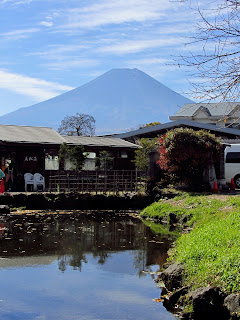 |
| Hachiko the Faithful Dog |
Well, I am pleased to say that we spent an appreciable time in all. I wrote about Shinjuku in this earlier post so I’ll talk about the rest here. Shibuya is of course known for the most famous traffic junction in Tokyo, Shibuya Crossing. This is a “scramble crossing”, in other words, the traffic stops completely and pedestrians take over, crossing to the exact side of the road which they want to go to. It is apparently one of the busiest traffic junctions in the world! We emerged at the “Hachiko” exit of Shibuya station - as everyone knows, Hachiko is the loyal dog who waited for its owner to come back at the station exit every day before they walked home together. Alas, one day, his owner had a heart attack and died before coming home. But the loyal pooch continued to wait for him, just the same until he too passed away. His statue now stands in the spot where he used to wait.
Incidentally, another famous icon of Japan is just by the Hachiko statue - Hello Kitty is the decor theme of the Tokyo Tourist Info Bus!
 |
| Scramble Crossing, from the L'Occitane Cafe |
After tea, we went shopping - there’s a lot of shops catering to a younger crowd here, but we didn’t go to them. Instead, we went to Tokyu Hands and Loft. My favourite stationery shops in Japan and maybe the whole world!!! Topped up my collection of washi tape, and bought some accessories for my handphone. I still have not used up all the post-its I bought the last time.
 |
| Our beef on a grill |
 |
| On Takeshita-Dori |
From Takeshita Dori, we walked to the Ometesando area. Just before that, we found Laforet, the departmental store for Lolita wannabes... we went in trying to find some Lolitas but again, not much luck. But it is still worth paying a visit, just to look at all the merchandise.
The Ometesando area is where all the more high-end shops are - again we didn’t really go to these. But there are also children’s shops, and small quaint little boutiques of all shapes and sizes. Just off the main road is Cat Street, which I initially had high expectations of but sadly, it was really just the street name. It is a small pedestrianised road which (again) has lots of charming, quaint little boutiques selling Knick-knacks and the like. Expensive ones, of course.
 What with all this walking, it was time for a cup of tea. We had read on-line about Q-Pot, which actually makes jewellery items (pendants, rings, earrings etc) which look like chocolates, biscuits and sweet things generally. So Q-Pot cafe is where they serve the desserts looking like jewellery. If you want a kawaii cafe, look no further! The table decor comprises towers of macaroons and where the lamps are jugs hanging upside down from the ceiling. The "necklace" plates display a lady wearing a Victorian/Edwardian era dress and the piece of cake is displayed like a necklace hanging around her neck.
What with all this walking, it was time for a cup of tea. We had read on-line about Q-Pot, which actually makes jewellery items (pendants, rings, earrings etc) which look like chocolates, biscuits and sweet things generally. So Q-Pot cafe is where they serve the desserts looking like jewellery. If you want a kawaii cafe, look no further! The table decor comprises towers of macaroons and where the lamps are jugs hanging upside down from the ceiling. The "necklace" plates display a lady wearing a Victorian/Edwardian era dress and the piece of cake is displayed like a necklace hanging around her neck.
Food itself was generally ok - I liked my "Russian Apricot Tea", served with apricot jam instead of sugar. I had the BisQuit Tiramisu on my necklace plate which was enjoyable, but not exceptional. You go for the experience, if you want to see the kawaii side of Tokyo.
I have to confess that after taking tea we were a little tired with all the walking and went back to the apartment. But the next day, we did come back to this area because we wanted to try out the sushi at Heiroku Sushi, which we had walked past on our search for Q-pot Cafe. Heiroku is supposed to be one of those well-known sushi bars where all the tourists go to, etc. And yes, we did have to queue, but fortunately it was not peak period so the wait was relatively short (and in any case it was good to take a little rest from all our walking). I have to say that it did not “wow” me as much as I would have expected and the plates coming out were all the high-end, expensive stuff. So you have to order the cheaper items! (I thought that it should be a better mix). But I suppose if you come to this area to shop, you would go for more high-end stuff :-)
More photos of everything on Flickr, here. In brief, if you want to go shopping, these shopping districts of Tokyo can satisfy all your needs and then some. But even for non-shoppers, these are interesting places to visit to do a bit of people-watching and just feel the vibe of this modern, exciting metropolis.
More photos of everything on Flickr, here. In brief, if you want to go shopping, these shopping districts of Tokyo can satisfy all your needs and then some. But even for non-shoppers, these are interesting places to visit to do a bit of people-watching and just feel the vibe of this modern, exciting metropolis.






